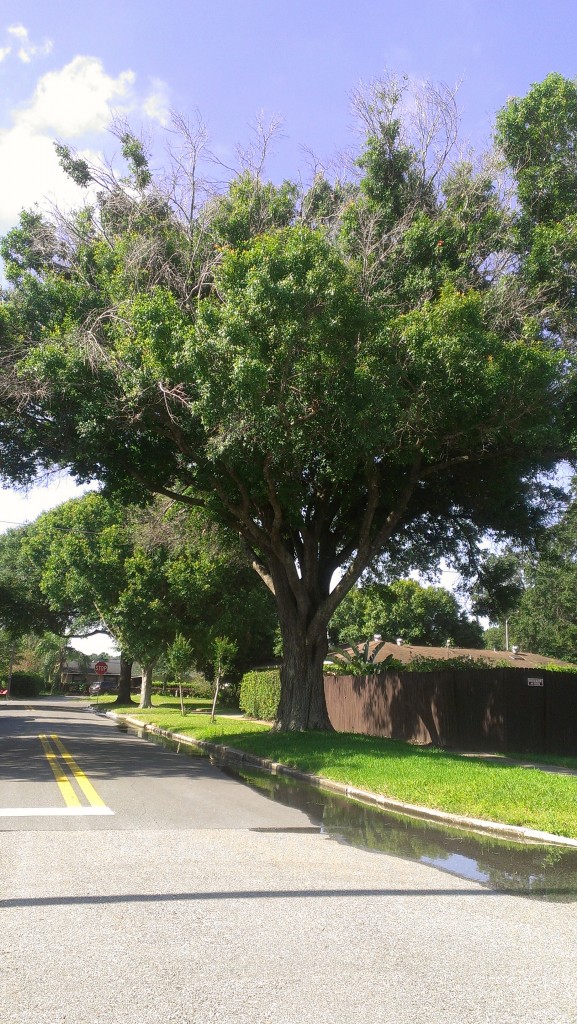Blog

WHY IS MY TREE IN DECLINE?
Sometimes the problem with exactly knowing “what happened to my tree?” and potentially why a tree goes into decline is not easy to determine. Often an arborist has to play detective asking the tree owner the history of the tree. If the owner has not been there since before it was healthy then at most an arborist can evaluate its current conditions and guess what “may have happened”.
Taking a closer look and inspecting the tree an arborist can evaluate current conditions and best explain what may have happened. In way too many cases something has happened to the root system. Over the years the landscape changes as new residents move in and out of a home.
Root of The Matter
Roots are the major support system of the tree. The larger tree roots act as an anchor while smaller, finer roots that branch off main roots pick up most of the water. Roots can potentially extend twice as far as its canopy. For example, a large live oak tree roots with a spread of 50 feet could potentially go 100 to 150 feet from the trunk of the tree. Knowing how far out tree roots grow and where they are mostly located (first foot of soil) helps determine the cause of decline. What affects the root system directly influences the shoot system or leaves up top. And vice versa; what happens up top influences health down below. If you have storm damage at top, some of the roots are not needed down below. Whatever happens down below can show up at the top in what is called decline. Areas of tip dieback in sections of the tree are due to lack of water and nutrients not being able to be transported to ends of branches/leaves.
Causes of Dieback
Number one cause of dieback an arborist sees in the field is buried roots. This can be from people. Yes, the added what arborists call “volcano” mulching piling high around trunks of trees are from what people do to trees. When you bury tree roots in dirt of mulch it suffocates them and puts them in decline. When the roots cannot function properly the top of the tree is not supported. Most of the work is done by the small absorption water roots which have to travel to the branches or top of the tree to support the shoots of the leaves. When you bury roots they decline and cause dieback at top. This picture is an example of the affects of many years of volcano mulching. The central part of the tree is in decline. Not good.

In this picture with the larger tree in the right-of-way you see a somewhat healthy Laurel Oak from the ground view. Walking by you wouldn’t notice anything. Look up and you notice dieback. I happen to know the history of this tree since it is my neighbor’s property. He decided to install grass close up to the trunk. He told me (7 years ago) that the tree roots were in the way and he was adding soil on top of the roots so the grass would survive. Well, it was choosing the tree or the grass in this case. Everything was fine leaving some of the roots exposed as nature intended. Other areas under the tree had grass. Why did they need to have grass all the way to the trunk? I warned him of the consequences but he was selling his house. The tree was the victim and now years later the tree has gone in decline. Causing what may be a pattern that may not turn around and make this tree more hazardous. Definitely more short live than its potential growth life. This tree has overall tip dieback in different areas of the canopy. Notice the large identical laurel oak behind it near the stop sign. This neighbor did not add soil. Has nice exposed buttress of roots at base of tree with NO tip dieback!
Another impact is construction near a tree trunk without protecting the tree from damage and change of soil grade. Taking or scraping away roots would common sense tell you the tree will be impacted yet many people don’t see this stage of clearing land before buying property. Developers will keep several older trees for a higher land value but buyers beware. Construction or root damage does not show up until years later. Questions to ask are: How old is the house? Has any construction happened close to the tree in the last 5 years? How about a new driveway, patio etc.? The tree may have been there before the house and has been impacted from the new construction.
Correcting a tree from dieback is minimal since the damage to the roots has already been done. If we catch it early, in the case of added dirt, then it is encouraged to remove it. You can also prune the tree from any deadwood from the dieback, keep it watered during drought times and on occasion fertilize if not fertilizing your grass. Having a professional certified arborist on hand is the best way to prevent more problems and evaluate trees before buying new property.
Put Your Trees In Capable Hands
Call on a licensed, insured, and certified arborist for tree prevention services
"Tree Doctor" Consulting fees are $150 for the hour on property to evaluate your tree and landscape.
Contact Us:
Website: www.orlandotreeconsulting.com
E-mail: info@orlandotreeconsulting.com
Phone Number: 407-476-9444


